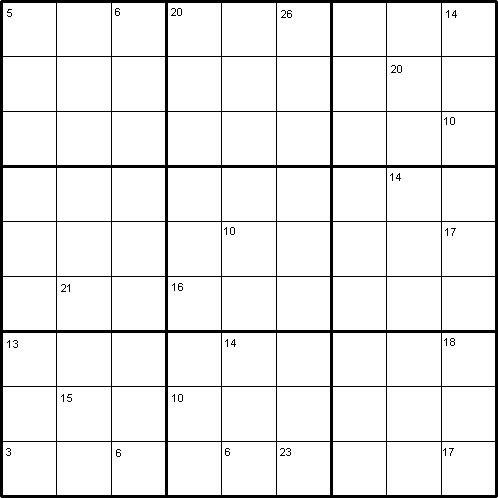Skip over navigation
by Henry Kwok

In the beginning, we do not know whether we should put 1 or 2 in the square (8,1) or in the square (9,2). If we put 1 in the square (9,2) and 2 in the square (8,1), we have to put 3 in the square (8,3) and 2 in the square (9,4) because of the small clue-number 6 in the square (9,3). If we put 2 in the square (9,2) and 1 in the square (8,1), we still have to put 3 in the square (8,3) and 1 in the square (9,4). We find that 3 will go to the square (8,3) regardless of where we put the rest of the numbers.
At least the answer for one square is confirmed. That's not too bad after all. Sooner or later, we shall be able to obtain the answers for the squares (8,1), (9,2) and (9,4) as we try to solve the rest of the puzzle.

Or search by topic
Number and algebra
Geometry and measure
Probability and statistics
Working mathematically
Advanced mathematics
For younger learners
Intersection Sums Sudoku
Age 7 to 16
Challenge Level 





- Problem
- Student Solutions
by Henry Kwok

The Rules of "Intersection Sums Sudoku"
Like the standard Sudoku, this Sudoku variant consists of a grid of nine rows and nine columns subdivided into nine 3$\times$3 subgrids. Like the standard Sudoku, it has two basic rules:- Each column, each row, and each box (3$\times$3 subgrid) must have the numbers 1 to 9.
- No column, row or box can have two squares with the same number.
A Short Demonstration
The square in the bottom left corner of this Sudoku contains the number 3. 3 is the sum of the digits in the two adjacent squares, which therefore must contain the digits 1 and 2.In the beginning, we do not know whether we should put 1 or 2 in the square (8,1) or in the square (9,2). If we put 1 in the square (9,2) and 2 in the square (8,1), we have to put 3 in the square (8,3) and 2 in the square (9,4) because of the small clue-number 6 in the square (9,3). If we put 2 in the square (9,2) and 1 in the square (8,1), we still have to put 3 in the square (8,3) and 1 in the square (9,4). We find that 3 will go to the square (8,3) regardless of where we put the rest of the numbers.
At least the answer for one square is confirmed. That's not too bad after all. Sooner or later, we shall be able to obtain the answers for the squares (8,1), (9,2) and (9,4) as we try to solve the rest of the puzzle.
You may also like
Geoboards
This practical challenge invites you to investigate the different squares you can make on a square geoboard or pegboard.

